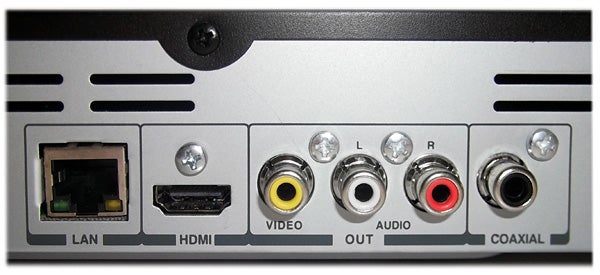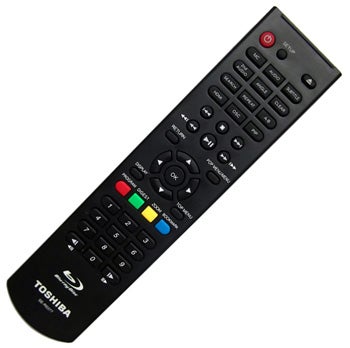Toshiba BDX3100 Review
Toshiba BDX3100
Following the launch of its 3D-ready LED TV range, here's our review of Toshiba's debut 3D Blu-ray player.

Verdict
Key Specifications
- Review Price: £174.99
Toshiba follows the launch of its 3D-ready LED TV range with its debut 3D Blu-ray player, the BDX3100. Its decision to join the 3D musketeers was inevitable given the current clamour for all things three-dimensional, but stiff competition from Panasonic, Sony, LG and Samsung, whose 3D decks are all teeming with other state-of-the-art features, means the BDX3100 has to work hard to impress – particularly with a price tag hovering around the £200 mark.
Aesthetically the player does nothing to stand out from the crowd, but its gloss black finish, slimline dimensions and angled fascia are effortlessly stylish. The front panel is fairly busy, with a few buttons dotted about, a USB port on the right and a large LED display in the middle, but because it’s all blended into the black finish it doesn’t feel cluttered. Build quality is solid too, making this a well-designed unit overall. 
However, the rear panel’s sparse line-up of sockets is a disappointment at this price. Firstly, there’s an HDMI v1.4 socket that outputs 3D pictures and HD audio (as well as supporting other HDMI trimmings like Deep Colour and CEC) but the single output may present a problem if your AV receiver lacks HDMI v1.4 inputs and can’t pass 3D pictures onto your TV. In that instance, you’d have to connect the HDMI output directly to your TV to watch 3D, but that means you can’t feed HD audio bitstreams to your amp at the same time, leaving the Dolby Digital and DTS-compatible coaxial digital output as your only way of getting surround sound (there are no multichannel analogue outputs either).
Also disappointing is the absence of a second USB port on the rear, which would have allowed you to keep a USB stick permanently connected for BD Live downloads and use the front port for occasional media playback. We’re not so bothered about the lack of component outputs, but it does underline the stripped back nature of this player. Completing the line-up are composite video and analogue stereo outputs, plus an Ethernet port for BD Live access.
That brings us to the player’s feature list, which pales in comparison to its big-name rivals. 3D is obviously the big talking point, but BD Live access is the extent of its networking capabilities, there’s no Internet portal and Wi-Fi support is off the agenda. Digital media playback via USB is supported, but DivX, MP3 and JPEG support is hardly likely to pique the interest of serial downloaders who want to watch their library of weird and wonderful video files in the living room. ![]()
It does, however, offer Blu-ray basics like Dolby TrueHD and DTS HD Master Audio decoding/bitstream output and 1080/24p video output for film purists. And something you don’t find on many Blu-ray decks in this price bracket is the wide range of picture adjustments in the setup menu. We’re not talking professional calibration here, but the choice of two separate adjustment menus – Video Processing and Motion Video Processing – might come in handy if the deck’s factory settings don’t quite meet the needs of your display.
The former allows you to set the levels of brightness, contrast, hue and saturation, with three additional levels of sharpness. The latter offers a choice of picture presets and another Custom video mode, which delves a little deeper with adjustments for individual colours and three noise reduction settings. We welcome this level of detail but it’s not without problems – as we noted on the BDX2100, changes made in one menu apply when adjusting the other, and because the two menus overlap in places it can have a detrimental effect if not used judiciously.
The other problem is that you can’t access the setup menu during playback, and therefore any picture adjustments have to be made blind. If you’re not satisfied with the results you have to hit stop and go through the whole process again – and as most Blu-ray discs don’t allow you to resume playback, you’ll lose your place in the movie too.
Aside from that though, the deck is remarkably easy to use. The modern-looking main menu is logically laid out and responsive, plus the setup menu options are self-explanatory and the lack of complex features at least makes installation simple. It’s controlled by a terrific remote, which may look and feel a little cheap but boasts faultless button placement and clear labelling.
Although it lacks the prowess of more expensive players and 3D peers like the Panasonic DMP-BDT100, the BDX3100 still delivers an impressive picture performance. The sharpness and stability of its pictures paves the way for crisp, focused 3D layering. With ”Monsters Vs Aliens”, the foreground figures are relayed with pin-sharp clarity, while finely detailed background objects and CG scenery boast a convincing sense of perspective, making the image seem deep and absorbing. Artefacts like ghosting and stepping are kept to a minimum.
As for 2D, the fine detail contained in the ”Iron Man 2” Blu-ray disc is conveyed with the sharpness it deserves, complete with the transfer’s inherent grain. The intricacies of the image are clearly visible, from the pinstripes on Tony’s jacket at the Stark Expo to wrinkles, pockmarks and strands of hair during facial close-ups. Text on computer screens is similarly well resolved and edges are emphatically defined. In fact, the factory sharpness setting is too much, making the picture seem slightly forced and false, so we recommend toning it down to take the edge off.
Colours are also perfectly pitched and consistently natural. Flesh tones are convincing, from Mickey Rourke’s leathery, bronzed face to Scarlett Johansson’s pale visage, while the light and shade on background walls are subtly blended. This excellent colour and detail reproduction also makes aerial shots of Monaco look spectacular, lending richness to the blue sea and the verdant green hillsides. Subsequent shots of brightly coloured race suits and F1 cars also pass muster.
From a more objective standpoint however, the Silicon Optix HQV disc reveals that its video processing isn’t completely flawless. With the Film Resolution Loss test, there’s some strobing in the centre and corner boxes – a sign that the deck isn’t processing the video cadence in the correct way – and there’s some moire noise and judder during the pan across the stadium. That said, the Video Resolution Loss pattern reveals faultless conversion of the video cadence, while both jaggies tests are handled without any artefacts – the white bars move smoothly with pristine edges.
It’s also worth noting that the BDX3100 loads Blu-ray discs quickly. ”Terminator Salvation” loaded up in just over 40 seconds, which is much better than many players on the market, while other discs like ”Hellboy II” and ”Iron Man 2” took around 30 seconds.
DVD playback is decent enough. Upscaled to 1080p ”Iron Man 2” looks clean and crisp, with very few artefacts to speak of and the deck’s CD playback is also enjoyable. HD audio piped to an AV receiver via HDMI sounds sensational.
Verdict
The BDX3100 is a respectable 3D Blu-ray player in its own right, offering solid picture quality, unusually generous video adjustments, a smart operating system and an attractive design. But its Achilles’ heel is the feature list, which lacks increasingly common stuff like Wi-Fi support, Internet content and DLNA streaming, plus format compatibility is limited. These features can be found on similarly priced players like the Panasonic DMP-BDT100, Samsung BD-C6900, Sony BDP-S570 and LG BX580, making them more sophisticated and therefore much better value for money.
Trusted Score
Score in detail
-
Performance 8
-
Design 8
-
Features 6
-
Value 7

